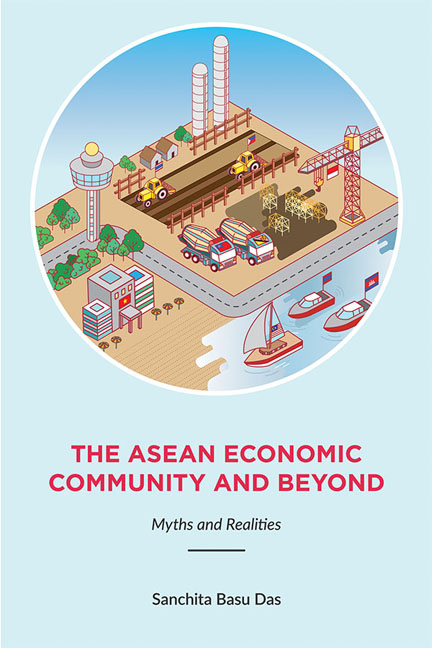Book contents
- Frontmatter
- Dedication
- Contents
- Foreword
- Acknowledgements
- Abbreviations
- 1 Introduction: The ASEAN Economic Community and Beyond
- I THE ASEAN ECONOMIC COMMUNITY (AEC)
- 2 The ASEAN Economic Community: An Economic and Strategic Project
- 3 Can the ASEAN Economic Community Be Achieved by 2015?
- 4 Goods to Flow Slow and Steady within the ASEAN Economic Community
- 5 The Limited Impact of the ASEAN Economic Community on Skilled Labour Migration
- 6 Five Facts About the ASEAN Economic Community
- 7 Growing Economic Diplomacy in ASEAN: Opportunities and Threats
- 8 Towards ASEAN Economic Community 2025!
- II BEYOND THE ASEAN ECONOMIC COMMUNITY
- III AN ASEAN PERSPECTIVE OF REGIONAL CONNECTIVITY
- Appendix: Summary of the Trans-pacific Partnership Agreement
- Index
- About the Author
4 - Goods to Flow Slow and Steady within the ASEAN Economic Community
from I - THE ASEAN ECONOMIC COMMUNITY (AEC)
Published online by Cambridge University Press: 19 May 2017
- Frontmatter
- Dedication
- Contents
- Foreword
- Acknowledgements
- Abbreviations
- 1 Introduction: The ASEAN Economic Community and Beyond
- I THE ASEAN ECONOMIC COMMUNITY (AEC)
- 2 The ASEAN Economic Community: An Economic and Strategic Project
- 3 Can the ASEAN Economic Community Be Achieved by 2015?
- 4 Goods to Flow Slow and Steady within the ASEAN Economic Community
- 5 The Limited Impact of the ASEAN Economic Community on Skilled Labour Migration
- 6 Five Facts About the ASEAN Economic Community
- 7 Growing Economic Diplomacy in ASEAN: Opportunities and Threats
- 8 Towards ASEAN Economic Community 2025!
- II BEYOND THE ASEAN ECONOMIC COMMUNITY
- III AN ASEAN PERSPECTIVE OF REGIONAL CONNECTIVITY
- Appendix: Summary of the Trans-pacific Partnership Agreement
- Index
- About the Author
Summary
The idea of a “single market and production base” in the ASEAN Economic Community (AEC) is to provide ASEAN consumers with more choices of goods at lower prices and offer regional producers more space for production activities. ASEAN member countries (AMCs) have made progress in reducing average tariffs to less than 1 per cent for regional trade. However, issues remain over the utilization rate of Common Effective Preferential Tariff (CEPT) preferences. Non-tariff barriers (NTBs) continue to prevail in the region, mainly in the chemical, machinery, and electrical sectors. These barriers are used as policy tools by AMCs to protect domestic interest groups. NTBs are most prevalent in Indonesia, followed by Vietnam. The ineffectiveness of NTB reform can be attributed to ASEAN's way of dealing with the issue — voluntary declaration and the absence of mechanisms of verification. Despite these issues, as a whole, AMCs have collectively benefitted, albeit in a limited way, from its action of tariff reduction and regular discussions on NTBs. AMCs’ “open regionalism” has helped integration by creating trade rather than diverting it. Going forward, key policy recommendations are: generating and maintaining political will for economic integration; generating greater awareness about the pervasiveness and impact of NTBs; streamlining NTBs and harmonizing them with existing international databases; increasing public AMC outreach activities with respect to AEC and its benefits; and pushing for domestic reforms in smaller economies such as Cambodia, Laos, Myanmar, and Vietnam.
INTRODUCTION
ASEAN member countries (AMCs) have made considerable progress towards economic integration since they decided to create an ASEAN Free Trade Area (AFTA) in 1992. Building on this base, they progressively launched other initiatives like the ASEAN Investment Area and the ASEAN Framework Agreement on Services. The process soon became wider in scope with the aim to create an ASEAN Economic Community (AEC). This is because, in its bid to make the region more globally competitive, ASEAN was no longer solely geared towards increasing intra-regional trade and investment, but was also concerned about reducing transaction costs, building soft infrastructure, lowering poverty, and pursuing economic development on a sustainable basis. At its core, AMCs have continued to maintain an outward-looking policy of “open regionalism”.
- Type
- Chapter
- Information
- The ASEAN Economic Community and BeyondMyths and Realities, pp. 34 - 50Publisher: ISEAS–Yusof Ishak InstitutePrint publication year: 2015



